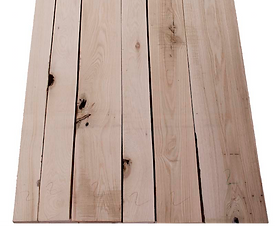
Red Oak
This very attractive, hard and heavy lumber is widely used throughout the world in furniture, flooring, cabinetry, joinery and architectural millwork. The wood is mostly straight-grained with a coarse texture and slightly less pronounced figure compared to white oak. Our red oak lumber comes from both the Glacial and Appalachian regions. All are graded after kiln drying and planing and offer unique quality consistency compared to commodity oak products. We sort our Glacial and Appalachian red oak by color to help reduce waste and produce cabinets and furniture with beautiful, uniform color tones.
Other Common Names: Quercus rubra
Sourcing Region: Northeastern United States and Southeastern Canada
Color, Pattern, Texture: Heartwood is a light to medium brown, commonly with a reddish cast. Nearly white to light brown sapwood is not always sharply demarcated from the heartwood.Grain is straight, with a coarse, uneven texture. The pores are so large and open that it is said that a person can blow into one end of the wood, and air will come out the other end: provided that the grain runs straight enough.
Common Uses and Applications: Cabinetry, furniture, interior trim, flooring, and veneer.
Working Properties: Produces good results with hand and machine tools. Has moderately high shrinkage values, resulting in mediocre dimensional stability, especially in flatsawn boards. May react with iron (particularly if wet) and may cause staining and discoloration. Responds well to steam-bending. Glues, stains, and finishes well.


Red Oak FAS, or Select and Better
The FAS grade, which derives from an original grade "First and Seconds", will provide the user with long, clear cuttings - best suited for high quality furniture, interior joinery and solid wood moldings.
Grades: FAS, Select & Better
Length and Width: Minimum board size is 6" and wider and 8' and longer. The FAS grade includes a range of boards that yield from 831⁄3% (10⁄12ths) to 100% clear-wood cuttings over the entire surface of the board. The clear cuttings must be a minimum size of 3" wide by 7' long or 4" wide by 5' long. The number of these cuttings permitted depends on the size of the board with most boards permitting one to two. The minimum width and length will vary, depending on species and whether the board is green or kiln dried. Both faces of the board must meet the minimum requirement for FAS.

Red Oak #1 Com
The #1 Com grade is often referred to as the Cabinet grade in the USA because of its adaptability to the standard sizes of kitchen cabinet doors used throughout the United States. #1 Com is widely used in the manufacture of furniture parts as well for this same reason.
Applications: Furniture manufacture
Grades: #1 Com
Length and Width: #1 Com grade includes boards that are a minimum of 3" wide and 4' long and will yield clear face cuttings from 662⁄3% (8⁄12ths) up to, but not including, the minimum requirement for FAS (831⁄3%). The smallest clear cuttings allowed are 3" by 3' and 4" by 2'. The number of these clear cuttings is determined by the size of the board. Both faces of the board must meet the minimum requirement for #1 Com.

Red Oak #2 Com
This grade is designed to yield shorter cuttings, with best face yielding a minimum of 50% clear-face cuttings with sound backs. We grade after drying and surfacing, and against all natural drying or surfacing defects (pin knot no defect).
Applications: Panels, drawer fronts, picture frames, toys, table leg
Grades: #2 Com
Length and Width: 2' and more lengths upon request - Widths from 3” and wider
